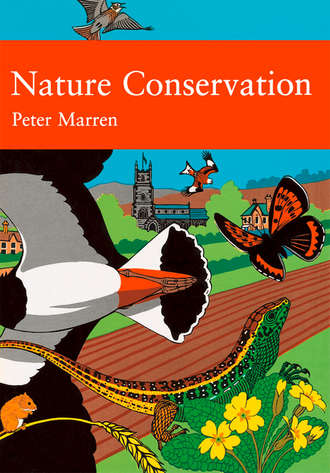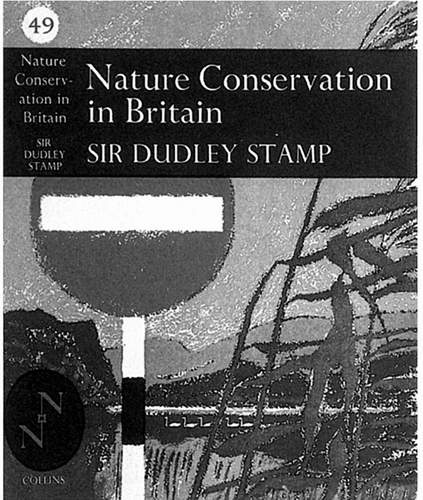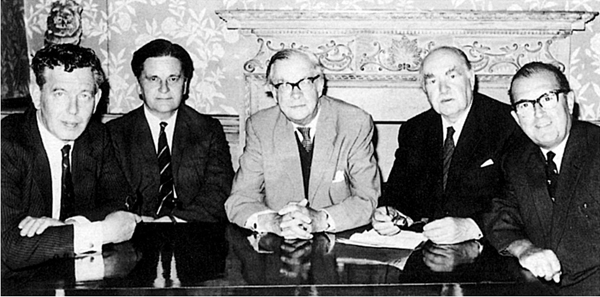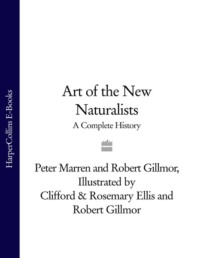
Полная версия
Nature Conservation

Collins New Naturalist Library 91
Nature Conservation
Peter Marren

Editors
Sarah A. Corbet ScD
S.M.Walters, ScD, VMH
Prof. Richard West, ScD, FRS, FGS
David Streeter, FIBiol
Derek A. Ratcliffe
The aim of this series is to interest the general reader in the wildlife of Britain by recapturing the enquiring spirit of the old naturalists. The editors believe that the natural pride of the British public in the native flora and fauna, to which must be added concern for their conservation, is best fostered by maintaining a high standard of accuracy combined with clarity of exposition in presenting the results of modern scientific research.
Dedicated to Derek Ratcliffe for reminding us that means should have ends, and that behind the posturing it is wildlife that matters
Table of Contents
Cover Page
Title Page
Editors
Editors’ Preface
Author’s Foreword
1 Introduction: Where We Are Now
PART I Dramatis Personae
2 The Official Conservation Agencies
3 The Voluntary Army
4 Conservation Politics: SSSIs and the Law
PART II Wildlife Habitats
5 Nature Reserves
6 The Farmed Environment
7 Woods and Forests
8 Bricks and Water
PART III Living With Wildlife
9 Development: Causes Célèbres
10 Animals That Get In Our Way
11 Biodiversity
12 Sea Eagles and Parrot’s Feathers: Invading and Settling
13 Summing Up: Whither Nature Conservation?
Appendices
References
Index
Plates
Praise
Copyright
About the Publisher
Editors’ Preface
It is 32 years since Dudley Stamp’s New Naturalist on Nature Conservation in Britain appeared. Published posthumously, it summarised events and progress up to 1965, concentrating on the dominant role of the official Nature Conservancy. Since then, nature conservation has become much more fraught and politicised. It is in continual conflict with the forces of modern ‘progress’, in the increasing demands made on the natural environment by agriculture, forestry, mineral extraction, water use, energy supply, transport, urban development, recreation and defence. The voluntary bodies for nature conservation have also grown to rival the official side in importance. These massive shifts require a completely new book that takes over the story where Dudley Stamp left off.
Peter Marren is the acclaimed author of the 50th anniversary volume, The New Naturalists (1995), whose earlier career was in the Nature Conservancy Council. As a regional staff member in Scotland and later England, he saw things from the front line of nature conservation. His later role, in compiling its Annual Report, gave him an overview of the whole wide field of activities and issues in which the NCC became involved, and an insight into the frequently political nature of skirmishes with opposing vested interests. Then the NCC was devolved, and Peter found himself in English Nature, with a much reduced geographical remit and a new management-cum-public relations style. Unable to stand the combination of internal regimentation and external timidity, he resigned, to start a new career as a freelance writer on wildlife and its conservation. To this he brought a distinctive style, of fluent prose allied to sardonic wit, winning many fans who relish the appearance of his next work.
Peter’s perceptive eye has ranged over an astonishingly broad field in this new book, and he has told its complicated story with his usual flair. This is an honest appraisal of the net results of all the years of striving on behalf of wild nature in Britain – an assessment of the balance between success and failure. He puts all aspects of the business under the microscope: the organisations concerned, the threats to nature, the measures for dealing with these, the politics involved, and the outcomes on the ground. The book is analytical as well as factual, but enlivened by its author’s characteristic flashes of humour. This re-evaluation shows that, despite many successes in saving important wild places, plants and animals, losses have also continued on an unacceptable scale. Nature reserves do, at least, give us some tangible reward for all the effort, but the results from the persuasion approach are often more difficult to measure. In giving us this invaluable reference work, Peter Marren has also conveyed the richness and splendour of our national capital of wild nature, and its importance to our cultural heritage. Its defenders also have sombre lessons to learn from this synthesis if they are to improve their performance during this new millennium.
Author’s Foreword
This is the first New Naturalist book on nature conservation since 1969. Its predecessor was written by Dudley Stamp, a geography professor and an influential voice in rural planning matters in the 1940s and 1950s. He was well qualified to report the early development of nature conservation in Britain, having been a long-time Board member of the Nature Conservancy, the original wildlife agency which he helped to set up in 1949. Stamp was also a well-practised writer of textbooks on geography and land use, and had contributed no fewer than four volumes to the New Naturalist library, including the outstandingly successful Britain’s Structure and Scenery. Nature Conservation in Britain was his last book, published after Stamp’s untimely death in 1966. It was a mellow look back at the past, broadly successful, quarter-century, in which conservation had developed from the hopes of a few naturalists to a broad-based going concern with its own mini-department in government. It was a relatively short book, concentrating on the work of the Nature Conservancy and the county wildlife trusts, and listing nearly all the nature reserves existing at that time.
Thirty years on, that world has changed utterly. Conservation has become a much more pluralist activity involving many sectors of society, both official and voluntary. It has broadened out from its original base in natural history to address fundamental issues like the future of the countryside and the claims of the urban majority on how land is used, and whether we should be allowed open access to it. It has become ever more difficult to say where nature conservation ends and concern about our own futures begins. Indeed, the very phrase nature conservation means something different today. It is now shot through with fashionable concerns like sustainability, animal rights and habitat creation, some of which might have baffled the conservationists of the 1960s, whose perceptions were rooted more in natural sciences and the development of institutions.

Nature Conservation in Britain (1969). The dust jacket designed by Clifford and Rosemary Ellis was inspired by the Abbotsbury swannery in Dorset, Britain’s oldest bird sanctuary.
Even so, many of the things Dudley Stamp was writing about are still with us. We still conserve wildlife by setting up nature reserves, or designating private land as Sites of Special Scientific Interest. What has changed more is the scale of the resources brought to bear on protecting nature. Bodies like the RSPB and National Trust have more members than any of the political parties or trades unions. Money has flowed into the business (as it has become) from the Heritage Lottery Fund, tax credits and the EU LIFE fund. We stand on the verge of a major shift of agricultural subsidies from food production to sustainable land use. If I was writing this book from the perspective of conservation bodies, that is, in terms of wealth and influence, it would be a story of unalloyed success. Instead, I have chosen to write it, as far as possible, from the more awkward perspective of wildlife. I try to assess to what extent all this power and money has benefited British wildlife, and how far the undoubtedly frenetic activity of the recent past has translated into policies that improve the lot of rare and declining species and wild places. Is the countryside in better shape today than in 1969? Do we have more wildlife now than we had then? Perhaps we should have. The population has hardly grown in that time, and the polluting industries of the 1960s have either cleaned up their acts or disappeared. Persistent pesticides are no longer widely used. And yet the statistics show a steady loss of habitats and species. Although in some ways land use has become more environment-friendly, a short walk with open eyes almost anywhere in Britain is a good antidote to the wilder claims of the prophets of the ‘Things are Much Better Now’ school.
Writing about the conservation product rather than the process poses an interesting problem. The documents of the conservation industry tend to be aspirational: they tell us, sometimes in impenetrable gobbledegook, sometimes in talk-down, creepy-vicar homilies, what ought to happen and what they would like to happen, but all too often do not tell us what actually happened. The emphasis tends to be on the means – plans, strategies, partnerships – rather than the ends. The Nature Conservancy and the NCC did sometimes review events from the standpoint of ecology and wildlife, but their successors seem much more interested in talking up their ‘achievements’. It is rare nowadays that a body tries to take an objective view and balance success and failure. A certain caution about the claims of conservationists is therefore healthy, and wise.
The conservation story would not make sense without a description of the main players, their basic beliefs and actions, and the historical framework against which decisions are taken. I therefore planned this book in three sections. The first concerns the main players, the official agencies, the successors of Dudley Stamp’s Nature Conservancy, and the voluntary bodies, and is also about how our wild places are protected. The second is about the playing field itself – the environment in which our wild species live, and what we have done with it over the past half century. The third is about species, especially those we know about and have polices for: the big ones, rare ones and new arrivals. The main text is topped by an introduction summing up the state of our wildlife at the start of the new millennium, and tailed by a look at where current trends might be taking us. I have not felt it necessary to review every wild habitat in detail; for example, I have not devoted much space to river engineering and floodland, partly because that has been done so well already by Jeremy Purseglove in his prize-winning book Taming the Flood (1989). Because this book is about the natural world, I have little to say about the human environment – food, renewable resources, radiation, ozone, carbon dioxide – nor ‘wider countryside’ issues such as access and recreation, except where they affect wild species and living communities. On the other hand, there is a lot about trees, flowers and birds, and, I hope, not too much conservation jargon.If it has an emergent theme, it might be the gap between aspiration and achievement. The political and physical conditions of a crowded island make the conservation of nature extraordinarily difficult, and wildlife survives largely despite us.
I am lucky to have friends in the business who agreed to cast their eyes over what I had written and put me straight on things, especially Desmond Thompson, James Robertson, Gary Mantle and Graham Bathe. I am grateful also to the three national conservation agencies, English Nature, SNH and CCW for the loan of photographs and other material, and for their patience in answering my queries. Among other bodies that helped in some way are the JNCC, Heritage Lottery Fund, the Countryside Agency and the Wildlife Trusts partnership, especially my own trust, the Wiltshire Wildlife Trust, as well as the RSPB, BTO, WWF-UK and the Marine Conservation Society. My old friend Bob Gibbons came to my rescue in the last-minute scramble for pictures with great generosity. My faithful Maureen Symons processed the script with her usual speed and cheerfulness, and Isobel Smales turned it into illustrated pages with sensitivity and intelligence. Thanks also to Myles Archibald at Collins for making it all possible. My old colleague and friend Derek Ratcliffe read the whole draft, and his comments, on the main themes as well as the detail, were most valuable. He would not necessarily agree with everything in it, but writing this book put me constantly in mind of Derek’s unique contribution to the protection of wildlife in Britain, and I am proud to dedicate this book to him.
Peter Marren Ramsbury, January-June 2001
1 Introduction: Where We Are Now
Wildlife in a crowded island
In his classic book, Nature Conservation in Britain (1969), Sir Dudley Stamp began with the world population. By the mid-1960s, wildlife shared the planet with 3,400 million human beings. Thirty years later that number had grown to 5,292 million. Today Asia alone holds most of the world population of the mid-1960s. In 2000, we broke the six billion mark. The United Nations forecast for 2050 is 9,833 million people; if so, in a single century the human population will have nearly trebled.
In Great Britain, by contrast, the population growth is slow. In 1921, nearly 43 million people lived on our island. In 1965, despite the postwar ‘baby boom’, the population had increased by only 19 per cent to 53 million. Today it stands at 57 million and is virtually static. Our population explosion happened early, in Victorian times. In the developing world, most people are young. In Britain we have an ageing population. Mr and Mrs Average will have 2.1 children and will live well into their seventies. If the size of the human population were all that mattered, the countryside and its wildlife would have been under remarkably little pressure in the twentieth century, except around a few cities, mainly in south-east England.
Even so, 57 million people is plenty on an island of only 230,000 square kilometres (88,780 square miles). It gives us an average population density of 3.6 persons per hectare in England, 1.36 in Wales and 0.65 in Scotland. We outnumber every wild mammal found in Britain, with the possible exception of the field vole. We outnumber the commonest wild bird by about five to one. If we all had a decent-sized garden, there would be no countryside.

The New Naturalist Board in 1966. From left to right: James Fisher, John Gilmour, Sir Julian Huxley, Sir Dudley Stamp and Eric Hosking. (Eric Hosking)
It is not the size of the human population so much as our changing ways of life that have created the pressure on our wildlife. Despite a near static population, another 4.4 million ‘homes’ are to be built over the next 20 years, at least half of them in the countryside. Apparently, this is because many people nowadays prefer to live on their own. Our devotion to the car has produced a bonanza of road building so that it can be hard to find a place where the traffic cannot be heard, and the stars shine in a dark sky. It has produced an American-style, road-centred landscape that was only starting to appear in the 1960s: flyovers, filling stations, shopping malls and multistorey car parks. Although roads are thin, they flatten a lot of wildlife sites. A clover-leaf motorway junction was built smack in the middle of Hook Common SSSI in Hampshire. Another motorway cut Aston Rowant National Nature Reserve in half (though zealous geologists promptly designated the road cutting). You get a wonderful view of bisected Kentish SSSIs from the M2.
Even so, if the rest of the countryside was still rich in wildlife, we could lose some of it to further our material convenience without losing any species. However, agricultural improvements, well under way by the 1960s, have transformed the old prewar mixed farms, with their acres of permanent pasture and miles of hedges, into prosperous modern arable units, or rye-grass-based milk factories. The reasons, which might seem inadequate now, made sense then. As a wise giant in Swift’s Gulliver’s Travels had observed, ‘whoever could make two ears of corn or two blades of grass to grow upon a spot of ground where only one grew before, would deserve better of mankind than the whole race of politicians put together’. We vastly exceeded that modest goal, but, essentially, the higher the unit production, the lower the value for wildlife. By the 1990s we had achieved what would once have seemed impossible: wheat fields with nothing left over for the wild birds to eat, or fields of grass with scarcely a single wild flower. Another crop that was starting to take over much of the poorer land in the 1960s was Sitka spruce. Forestry was once considered by many to be a friend to nature conservation. Unfortunately the industry went the same way as farming – trees were treated purely as a crop, like wheat – and so it lost the favourable reputation it is now struggling hard to regain. The nation could have fed itself without destroying important wildlife habitats, and the heavily subsidised home-grown trees scarcely dented Britain’s import bill for timber. The destruction of our wild places, it seems now, was unnecessary. If it had a single cause it was an airtight Ministry of Agriculture, the client ministry of the big farming unions and the agro-chemicals industry, but no one else. When the Ministry was finally put to sleep in the government reorganisation of June 2001, no one, least of all the farmers, had a good word to say for it. The officials of MAFF, it is said, were the most blinkered and obstinate in the entire civil service (ask anyone in a conservation agency – or for that matter, on a farm). They made a mess of everything, from BSE to ESAs. The chaos that engulfed the farming industry in the 1990s was the endgame of decades of preventable idiocy.

The New Naturalist Board in 2001. From left to right: Richard West, David Streeter, Derek Ratcliffe and Sarah Corbet. Max Walters is absent from the picture. (Debra Sellman)
A high-density human population makes every acre precious. As Dudley Stamp noted, ‘nature conservation must work out its own salvation in cramped conditions’. Good wildlife habitat, such as chalk grassland and heath, has been reduced to scraps within a predominantly arable or urban environment. Many of our nature reserves seem ridiculously small to visitors from large, continental countries like the United States. Yet the same visitors also marvel at how attractive much of our countryside still is, despite all the pressures upon it. The island scale of the British landscape means that small is often beautiful. Britain has an amazingly complex geology, producing variations in landforms and building stone within just a few miles. A traveller from London to Brighton passes over at least seven different landscapes on gravel, clay, greensand and chalk, past downs, heaths, woods and secluded lakes. The lowland agricultural landscape is a patchwork, and small nature reserves may be big enough to enclose some of the best examples of natural habitats. Even so, in the long run they may still be too small. Even quite large nature reserves cannot do much for wide-ranging, low-density species such as wildcats or golden eagles. Small reserves tend to lose more species than large ones. A famous example is the inability of Woodwalton Fen, a small, brick-shaped nature reserve in Cambridgeshire, to sustain a population of the large copper butterfly. The butterfly survived through the 1930s and 1940s, when the weather was kinder, but the reserve was just not big enough when the going got tough later on. Because they are small, British nature reserves tend to be highly planned, with various zones and prescriptions designed in effect to squeeze the maximum of wildlife out of the minimum of space. Like farms, every acre has to count, which is why there are few places where wildlife is simply left to look after itself. A special site (a steep ravine) had to be found to study the natural development of woodland in Britain. So ingrained is the concept of management that in Britain we do not seem very interested in how the natural world actually works.
This would seem odd in a big, wild country such as Canada or Brazil, but, as we ecologists never tire of pointing out, every inch of Britain is used. Most of the land has a history. Most of it is privately owned, and managed to provide income. British wildlife has long been used to living with the British, and exploiting such opportunities as we offer it. Presumably any species unable to make that crucial accommodation, such as the wolf perhaps, or Cerambyx cerdo, a huge beetle of giant trees in virgin forests, died out. But it is quite wrong to assert that because he has planted a few trees and hedges, and farms most of it, that the landscape is therefore man-made. This is a sinister reasoning, because if man has created a landscape there is an implication that he is entitled to do with it as he likes, and, if necessary, destroy it. In fact, many of our wilder places are almost unfathomably ancient, and were never planned or created. Most of our woods and commons, and even some hedges, evolved naturally in ways that are still mysterious. Whoever coined the term ‘natural history’ must have realised this instinctively. In Britain, nature does indeed have a history that runs parallel with that of humankind, often in harmony with it (man and nature in harmony is the subject of much of British art). Our relationship with the natural world has a history of its own (see, for example, Keith Thomas’ masterpiece, Man and the Natural World). Nature conservation is only the most recent phase in a long-running love affair.
Britain’s oldest farmed habitats can in fact be more ancient than natural landforms. For example, the fields of West Penwith, in Cornwall, with their strange polygonal patterns, are much older than the shingles at Dungeness or the wet levels at Pevensey, which were still under the sea when William the Conqueror invaded in 1066. A few woods have been managed in much the same way for as long as historic records permit us to see (and to carry on managing them in exactly the same way is absolutely the right thing to do: indeed, it is almost a duty to history). Past land uses were not necessarily ideal for wildlife, but they tended to leave plenty of opportunities. Butterflies could lay their eggs in sunny glades created by woodmen, before the canopy closed over again. Meadows were often full of wild flowers because farmers lacked the means to drain them dry or improve the soil (flower fields also made better hay). The highly regulated management of medieval commons could almost have been invented by a latter-day nature reserve manager. Modern conservationists are to some extent stepping into the vacated shoes of farm labourers, shepherds, woodmen and peasants, who would not have been able to read a conservation manual but knew more about conservation in practice than most of us. The challenge today is to obtain similar results by different means. Recent advances include the creative use of bulldozers, JCB diggers and suction dredgers.



